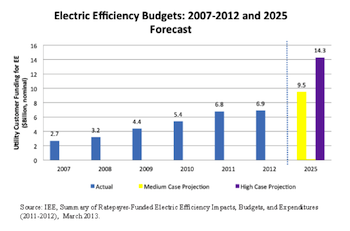$6.9 Billion For Energy Efficiency
SustainableBusiness.com News
State-level support for encouraging utilities (and by association their rate payers) to become more energy-efficient continues to grow, reports Innovation Electricity Efficiency (IEE), part of the Edison Foundation.
The budgets for these programs rose 27% to $6.9 billion last year and could exceed $14 billion by 2025, reports IEE.
“Supportive regulatory frameworks are the key to expanding the electric power industry’s already large commitment to electric efficiency even further,” says IEE Executive Director Lisa Wood. “Through them, the power industry provides integrated programs to help customers manage energy use, more fully utilize flexible demand resources on the power grid making it more efficient, and serve as a consistent and comprehensive point of contact to support all customer energy needs.”

Three types of regulatory mechanisms are critical for supporting energy efficiency investments: direct cost recovery, fixed-cost recovery, and performance incentives, says IEE. Here's a summary of their intent:
Direct Cost Recovery helps utilities recoup costs related to administration, marketing and the actual cost of product rebates.
Fixed Cost Recovery allows utilities decouple their revenue models and expectations from the amount of electricity sold. Since the goal of efficiency programs is to reduce consumption, this allows them to recover fixed operating costs in a more timely manner.
Performance Incentives reward utilities for reaching certain efficiency goals, and, in some cases, impose a penalty for performance that falls below agreed-upon goals.
The IEE report, "State Electric Efficiency Regulatory Frameworks (July 2013)," finds that 32 states offer some type of fixed-cost recovery mechanism to align utility fixed costs with investments in energy efficiency programs, up from 27 states in last summer's report.
Here are some other highlights.
- 28 states currently have performance incentives in place, up from 23 states previously. Another three are considering them: Mississippi, Montana and West Virginia.
- 18 states offer lost revenue adjustment mechanisms, including Missouri and Louisiana, and another two are awaiting regulatory approval, Mississippi and Virginia.
- 14 states support electric decoupling, including Washington; Delaware is awaiting a decision on its own legislation.
When it comes to the effectiveness of energy efficiency initiatives, Massachusetts has lead the way for the past two years, edging out California for that distinction.
That's because Massachusetts has established energy efficiency as the state's 'first-priority' energy resource. Utilities must offer rebates and other incentives encouraging ratepayers to upgrade lighting, air conditioning, and industrial equipment to more efficient models, whenever those incentives cost less than generating the electricity it would take to power their older, less-efficient equipment. It was also among the first states to support decoupling.
Read the IEE report for more details on each state's program:
Website: http://www.edisonfoundation.net/iee/documents/iee_stateregulatoryframe_0713.pdf
http://www.sustainablebusiness.com/index.cfm/go/news.display/id/25099